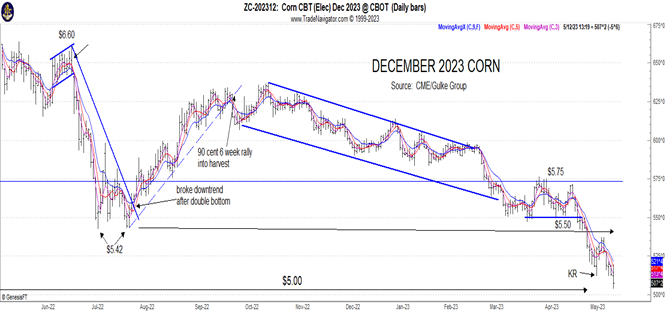Jerry Gulke: How to Manage Volatility in a Weather Market

Grains had a strong close on Friday as the speculative crowd put in a weather premium before the weekend. July corn was up 16½¢ at closing at $6.09, which is back above key moving averages and the psychological $6 mark. December corn ended 11¼¢ higher at $5.41½. For the week, July corn was up 5¢, with December up 6¾¢. Soybeans also closed 23¢ higher on the July at $13.52¼, with November up 14¾¢.
Although it was volatile week, Jerry Gulke, president of the Gulke Group, says he was encouraged with corn and soybeans closing higher Friday and near their highs for the session. That tells him the weather market, which is still in its early stages, hasn’t run out of steam yet. However, he says, this week’s price action reflects the volatility we normally see in a weather market.
So where does the market go from here? Of course, it depends on the weather and if the extended forecasts continue to be dry in much of the Corn Belt. Gulke says there is room for a sizeable rally, especially with the funds leaning short in the grain complex.
How high could prices go, and will December corn be able to take out $5.50 resistance on the charts?

“If we get above that we have a real weather problem,” he says. If the weather stays dry past mid-June, Gulke predicts it will trim yield and be difficult to achieve the record 181.5 bu. per acre yield predicted by USDA.
He says if the national average corn yield falls below trendline to 179 bu. per acre, it will have a bullish impact on the market. If a prolonged dry period moves yield down to 176 bu. per acre, there could be some real fireworks and the market could move above $5.50.
“Of course, the high on December corn was over $6 from October 2022 through February 2023. Those are marks on the chart that were made under different fundamental situations. And now we have to assert what is $6 corn compared to two months ago before we knew all this,” Gulke explains.
He advised clients to lift hedges in December corn at $4.90 and take profits in mid-May. Now he's waiting for a place to reenter the market. He’s watching the chart action to provide that signal and says when corn closes lower on Friday or fails to post a higher weekly close that might be an indication the market is starting to lose momentum.
“You don’t want to see the market close on the lows for the week,” Gulke says.
Going forward, he says the markets need to make higher highs and higher lows to indicate the trend is still intact. The real key is the weekly close. "We need to close higher even if it's just a small amount, and certainly not below the previous week's low. For next week the line in the sand is the $5.10 to $5.12 area, nearly 30-cents below where it closed Friday." To do so would remove the weather premium.







